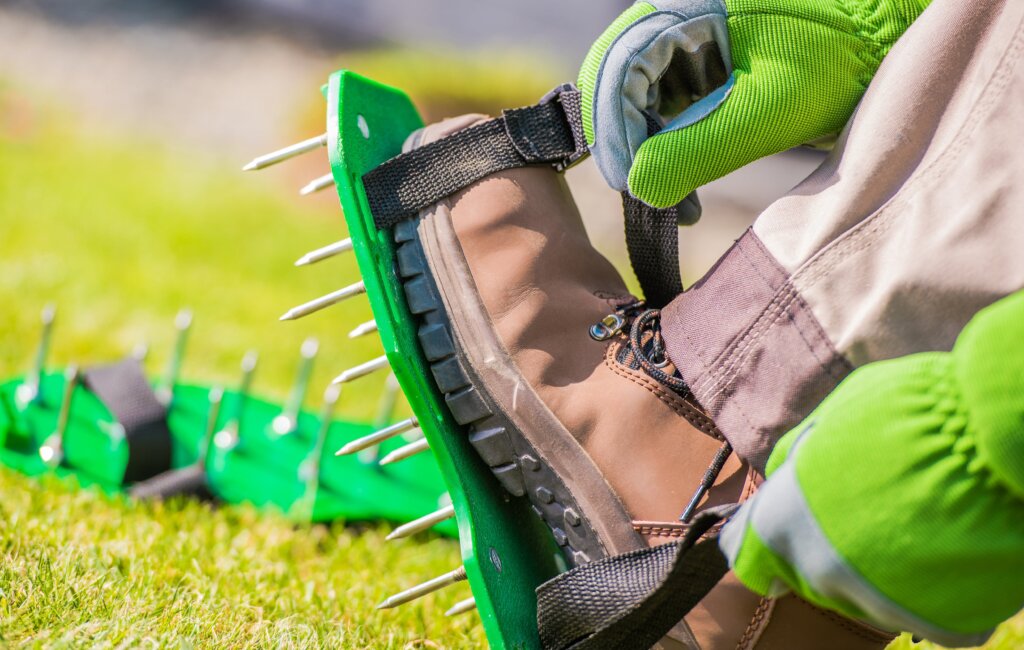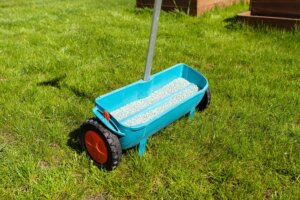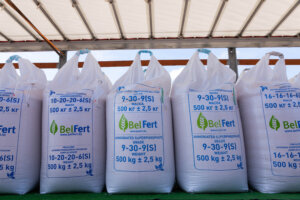Pennsylvania lawns deal with dense clay soil, heavy seasonal rainfall, and frequent foot traffic. Knowing how to aerate lawn conditions specific to PA can make the difference between thin, stressed grass and a yard that stays actively growing throughout the year. Terra Lawn Care, a locally owned company serving PA since 2003, uses agronomist-guided lawn practices that follow the same methods outlined in this guide.
Key Takeaways
- Aeration improves soil and roots: Pulling ½–¾ inch plugs 2–4 inches deep helps air, water, and nutrients reach grass roots, essential for Pennsylvania’s compacted clay soil.
- When to aerate: Early fall is best for cool-season grasses; early spring works for small areas. Warm-season grasses recover in late spring to early summer.
- Choosing the right tool: Core/plug aerators relieve deep compaction and high-traffic areas, while spike aerators or garden forks only create shallow holes.
- Steps to success: Moist soil, marked sprinkler heads, multiple passes, leaving plugs, followed by overseeding and watering.
- Signs your lawn needs aeration: Pooling water, thatch >½ inch, thinning grass, weeds, and hard soil.
- Bottom line: Core aeration in early fall provides measurable soil improvement and healthier grass, while PA homeowners can rely on Terra Lawn Care for expert, agronomy-backed results.
How to Aerate Lawn (Step-by-Step for PA Conditions)

Aeration is the process of poking holes or pulling soil plugs from the yard to alleviate soil compaction and help air, water, and nutrients reach the roots. Here’s how to aerate your lawn properly:
1. Check Soil Moisture
Aerators work best in moist soil. Aerate one day after rain or give the ground a deep soak.
2. Mark Sprinkler Heads and Shallow Irrigation Lines
Pennsylvania homes often have older irrigation systems, so flag your sprinkler heads to avoid damage.
3. Choose the Right Aerator
For most PA lawns—especially compacted or high-traffic areas—use a core aerator. Spike tools can be used for small areas, but they don’t alleviate soil compaction as effectively.
4. Make Multiple Passes
Move the machine across the entire lawn in two directions to pull enough holes and soil plugs from the soil surface.
5. Leave Soil Plugs on the Lawn
Allow plugs to break down naturally. They help integrate topsoil into thatch and accelerate recovery. For additional guidance on keeping a newly aerated lawn healthy and thriving, this Pennsylvania-focused resource explains the next steps to take: Aerate to Keep Your Lawn Healthy and Thriving
6. Overseed and Water
A newly aerated lawn responds exceptionally well to overseeding. For best results, follow guidance from the resource on getting the right results when aeration and overseeding are combined, available in this detailed guide: Aeration and Overseeding: Make Sure You Get The Right Results
Lawn Aeration: Why Pennsylvania Yards Need It
PA soil tends to compact quickly due to clay content and seasonal freeze-thaw cycles. Compaction restricts air movement, traps water at the soil surface, and weakens grass roots.
To understand the science behind lawn aeration and its benefits, homeowners can review this guide on the Benefits of Lawn Aeration, which explains nutrient flow, ground oxygen movement, and long-term soil health. Terra Lawn Care’s in-house agronomist—backed by 15 years of golf course experience—oversees every PA lawn treatment to ensure compaction is reduced safely and effectively.
Aerate Your Lawn: Best Timing for Pennsylvania
PA homeowners should aerate during seasons when grass is actively growing so the lawn can recover quickly.
- Early fall (ideal): Cool-season grasses, longer nights, and moist soil help plugs break down faster.
- Early spring: Acceptable for small areas, but avoid late spring or early summer when heat stress can slow recovery.
For a region-specific breakdown, review the timing guide here: When Should You Aerate Your Lawn?
Spike Aerator: When It Works (and When It Doesn’t)

A spike aerator pushes holes into the soil without removing material. While spike aeration can help break through a light thatch layer or small lawn sections, it is less effective for compacted PA soil.
Learn more about different aerator machines in this guide on lawn aerators: Demystifying Lawn Aerators: Understanding Their Function and Impact on Your Lawn
Spike Aeration vs Core Aeration
Both methods help aerate your lawn, but they differ significantly in how well the lawn can recover and how much compaction they actually relieve.
| Spike Aeration (Spike Aerator) | Core Aeration (Plug/Core Aerator) |
|---|---|
| Pushes holes into the lawn without removing soil; works for a small lawn or light surface compaction. | Pulls soil plugs out of the ground, reducing deep soil compaction and helping the lawn recover faster. |
| Can compress soil around the holes, offering temporary improvement only. | Opens channels for air, water, and nutrients to reach grass roots for long-term health. |
| Best for quick fixes, breaking light thatch, or areas you can reach with a rake and simple tools. | Ideal for compacted Pennsylvania soil, high traffic areas, and prepping the yard for mowing and overseeding. |
| Useful when you need a fast method to aerate without large equipment. | Opens channels for air, water, and nutrients to reach the grass roots for long-term health. |
For a full look at when each method is appropriate and how they compare to dethatching, review this guide on Lawn Aeration vs Dethatching.
Core Aeration for Cool and Warm Season Grasses
Most Pennsylvania lawns are cool-season grasses, which respond best to early fall core aeration. Warm-season grasses are less common in PA, but when present, they benefit from aeration in late spring or early summer when they are actively growing.
For PA’s most effective seasonal method, review the fall-specific guide here: Should You Aerate Your Lawn in the Fall? Here’s Why It’s the Smart Move
Plug Aerator: Why PA Lawns Benefit Most
A plug aerator (core aerator) pulls soil plugs from the yard, relieving compaction and allowing grass to regrow with deeper, healthier roots. This is especially important for homeowners with high traffic areas, large yards, or compacted clay soil. A detailed schedule for how often you should pull soil plugs is available here: How Often Should You Aerate Your Lawn?
Garden Fork Aeration: Is It Ever Worth It?
Tools like a garden fork, shovel, or even golf shoes can poke holes in the soil surface, but they offer limited impact. These tools can help in small areas but won’t address deep compaction or thatch.
According to the University of Maryland Extension, mechanical aeration that removes soil plugs is far more effective: core aerators pull plugs about ½- to ¾-inch in diameter and 2–4 inches deep, creating large pores that let oxygen, water, and nutrients penetrate deeply — a benefit that spike-type tools or fork pokes cannot match.
For homeowners without equipment, PA-specific services are outlined on Terra’s lawn aeration service page.
How to Tell If Your Pennsylvania Lawn Needs Aeration
Most people notice aeration issues long before the lawn fully declines, especially in PA’s compacted soil conditions. Common signs include:
- Water pools on the ground after rain
- A thatch layer thicker than ½ inch
- Heavy weeds caused by weak turf density
- Grass thinning in high-traffic areas
- Hard, compacted soil that’s difficult to dig through or penetrate with a shovel
Homeowners across Terra’s Pennsylvania service area often report these symptoms before scheduling aeration, which makes early intervention especially important.
Bottom Line
Understanding how to aerate lawn conditions in Pennsylvania ensures your grass gets the air, water, and nutrients it needs to thrive. Early fall remains the ideal season, and core aeration is the most effective way to alleviate soil compaction and support deep, healthy grass roots.
PA homeowners who prefer expert guidance can turn to Terra Lawn Care—a family-operated company with over 50 years of combined agronomy-based experience. For questions about your yard’s location, soil needs, or aeration scheduling, contact Terra Lawn Care today.
Frequently Asked Questions About How to Aerate Lawn
Aeration is generally safe, but doing it at the wrong time can stress your lawn. Aerating during hot spells, on dry soil, or before heavy weed growth can slow recovery. After the job, you may see small soil plugs on the surface—this is normal in Pennsylvania’s clay soil.
To support healthy regrowth, lightly rake the plugs into the lawn, follow proper seeding and fertilising, and avoid heavy mowing for the next couple of weeks. Lawn aeration also helps remove barriers to water and nutrients, giving your grass roots room to grow.
In Pennsylvania, the ideal time is September. Cool-season grasses are actively growing, and the soil is moist, which helps soil plugs break down faster. Aeration at this time allows you to overseed and apply fertilisers so your lawn can recover efficiently.
Homeowners in the community can also pair this with basic gardening tasks like raking and mulching for better overall lawn health.
Your lawn may need aeration if water pools on the surface, the soil is hard, or the grass is thinning in high-traffic areas. You might also notice difficulty inserting a shovel or uneven growth.
Performing lawn aeration helps rid compacted soil and opens channels for air, water, and nutrients. After aerating, follow up with seeding, light mowing, and a proper post-care routine to maintain soil health.
For Pennsylvania lawns, a plug aerator is usually the better choice because it removes soil plugs, relieving compaction and allowing your lawn to recover fully. Spike aerators are suitable for smaller areas or light compaction, but they can create temporary barriers if overused. After using either tool, rake the lawn lightly, water properly, and plan for seeding or fertilising to support new growth in the next couple of weeks.



